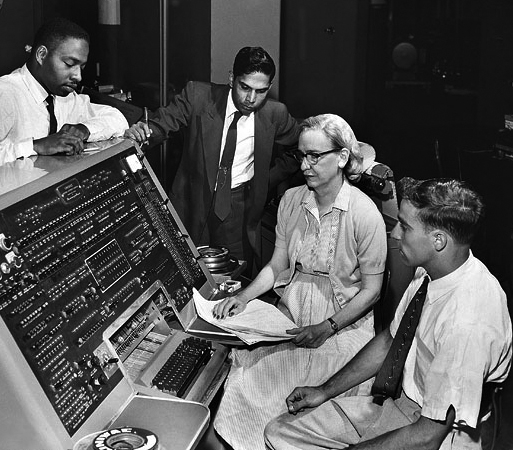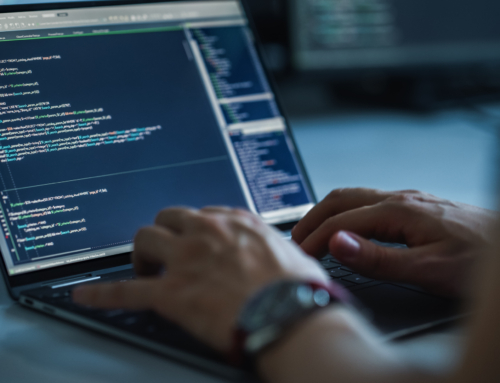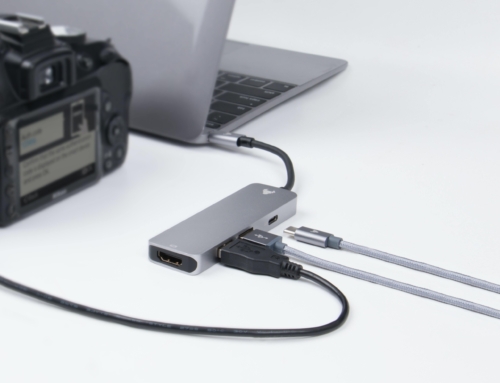“One small step for man,” says Neil Armstrong as he exits the lunar module and places his foot onto the moon’s surface. Little did we know, it was a woman who ensured that the lunar module landed safely and that the mission ended as a success.
Where Are All the Women in Programming?
In recent years, many studies have been conducted in an attempt to solve the question as to why aren’t women in programming and Computer Science, among other STEM fields.
“The pipeline for getting girls into engineering and other STEM fields starts when they are about six.” – Komal Singh
Google Cloud Blog Team
When girls are the shero of the story
As it turns out, it’s not an issue of ability or performance like some have previously claimed.In fact, research shows that during K-12 education, boys and girls perform nearly identically in mathematics and science.
It isn’t until the post secondary level, where students choose their majors. When majors are selected the gender disparity in computer science begins to emerge.
One explanation for the gender disparity in computer science is that girls simply aren’t aware of the vast number of influential women in programming.
Turns out, few people know the real facts about women programmers and the contribution they made.
31% of women were computer and information science graduates.
According to National Center for Education Statistics, women made up over 31 percent of all student graduates with computer and information science degrees.
Women coders were booming and seeking education in programming until the drop off in the mid 1980’s.
But, what does it look like today?
To put things into perspective, women are earning just 18% of computer science degrees. While earning 57% of bachelor’s degrees across all other fields and 50% in science and engineering.
Why Aren’t Women in Computer Science?
Over the last few centuries, women in computer science and women coders have been largely under-represented and marginalized in the supposedly male-dominated fields of Science, Technology, Engineering, and Mathematics (STEM).
Open any history book—some will point out — and you’ll find almost nothing on women… Only men listed as contributors and inventors.
But, this doesn’t exactly represent the truth in its complete form. Rather, it reflects a society that has celebrated the men who’ve contributed to the development of Computer Science.
Meanwhile, women roles in computer programming and the incredible women who have pioneered the field are ignored.
It seems that the role of women in computer science has been whitewashed from the history books, leaving any potential female role models forgotten.
As a result, girls just can’t see themselves becoming a programmer or computer scientist—it’s simply not part of the narrative.
Due to our society promoting the idea that computer science is a career for men, few girls ever make a passing glance or pursue the field.
Computers are “Women’s Work”
Ironically, programming and operating computers were actually seen as “women’s work” in the early 1940s, as virtually all workers in the field were female.
In fact, the very first jobs in computer history were done by women. Meaning, computing and telecommunications were performed by women from the beginning! How, then, did we develop the myth that girls don’t belong in Computer Science?
In this article, Woz U gets the story straight by talking about some of the greatest female minds behind the development of Computer Science.
Our society and the people need to understand the incredible achievements of these women and how they changed the course of human history.
The First Programming Language
In the mid-1800s, an English mathematician and inventor named Charles Babbage created a blueprint for the first mechanical computer.
Despite his genius, Babbage decided that this computer should be used for calculations and failed to see the full potential of his own machine. That is, until Ada Lovelace came along.
Ada Lovelace was a mathematician and member of English nobility. Lovelace took a look at Babbage’s new computer and realized that the machine was much more than a clunky old calculator.
Using her mathematical prowess, Lovelace wrote the first algorithm to be carried out by a computer. Ultimately, earning her the title as Ada Lovelace the first computer programmer in history.
World War II
While the men were fighting overseas, it was the women who worked in the factories and maintained the production of supplies to support the military.
Besides building B-52s and bombs, however, women played a huge variety of roles in communications and computer programming.
In the U.K, women in programming like Joan Clarke worked side by side with Alan Turing. Clarke and Turing worked on the machines that were used to break the Enigma code.
If your wondering, what is the enigma code -it’s the secret language used by the Nazis to send encrypted messages to each other.
While completely attributed to Alan Turing in history books, Clarke played a pivotal role in deciphering the code and helping the Allies win WWII.
Other female cryptographers in the U.K. also broke the Italian Navy’s secret code, which helped turn the tide of the war.
The First Compiler
In addition to being one of the most decorated women in the U.S. Navy, Grace Hopper developed the first computer compiler and made programming easier for all of us.
Before then, all programming languages involved typing in numbers and symbols, which were often hard to remember.
She noticed the difficulty in remembering all of these complex commands and figured it would be easier for programmers if they could type in plain English.
Grace Hopper also played a pivotal role in early computing by helping to develop the Harvard Mark I computer and the UNIVAC I.
Over the course of her lifetime, she made huge contributions to the field of Computer Science. She earned over 40 honorary degrees and the National Medal of Technology.
The computer science legend even had a U.S. Navy warship and a supercomputer named after her!
In 2016, Hopper was posthumously awarded the Presidential Medal of Freedom by President Barack Obama.
The Moon Landing
“One small step for man,” says Neil Armstrong as he exits the lunar module and places his foot onto the moon’s surface.
If we didn’t know any better, we might assume that the Apollo 11 mission was indeed a step for man. However, as it turns out, it was a woman who ensured that the lunar module landed safely and that the mission was a success.
Margaret Hamilton, a computer scientist at NASA, developed the on-board flight software for the lunar lander.
It was this legendary female computer programmer who ensured the United States would be the first nation to step foot on the moon.
At one critical point in the Apollo 11 mission, problems with the power supply could have meant a crash landing for the lunar lander.
Thanks to Margaret Hamilton’s software expertise, the computer was able to divert processing power. This process diversion on Apollo 11 helped handle the most important tasks involved in the landing and issued a warning to the crew.
It also notified the astronauts and ground control that they would have to choose whether to attempt to land or abort the mission.
Shortly after, ground control approved of the landing and the crew arrived safely on the moon’s surface, changing the course of human history forever.
Conclusion
Why is it important to have women in computing?
When it comes to women in computer science and programming, we hope this question is now answered.
The idea that women don’t belong in Computer Science or that they aren’t capable of becoming successful programmers is historically unfounded.
While men overwhelmingly dominate the field today, women in programming like Ada Lovelace, Grace Hopper, and Margaret Hamilton pioneered it.
Girls today who are interested in coding need to be told the stories of these women technologist who have paved our way through computer history.
Learning about the history of women in programming is a must for girls to find inspiration and awaken their true potential.
At Woz U, we celebrate diversity in tech and we believe that getting women and girls involved in Computer Science is good news for our world and for gender equality.
We want girls to know that they too can pursue a career in Data Science, Software Development, and Cyber Security. Women no longer have to feel a false sense of inferiority in comparison to their male counterparts.
On the contrary, girls who are interested in coding can find inspiration in the stories of the women in programming who created the path before them.






